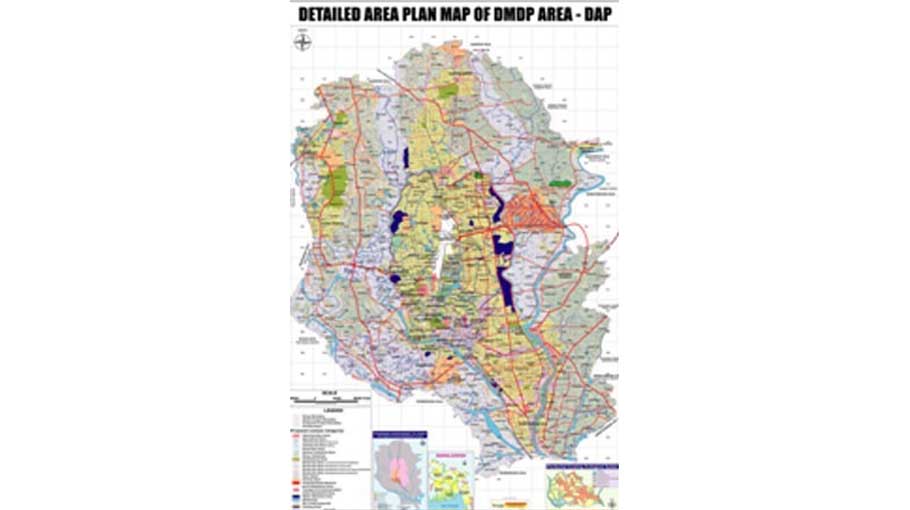6 years on: DAP yet to be finalised

Dhaka is home to many initiatives and projects, however, delays in the projects prolong its development. After years of wait, the city dwellers are likely going to get the 20- year plan, Detailed Area Plan (DAP) 2016-35, for Dhaka.
It has been six years, but the 20-year Detailed Area Plan (DAP) of the Rajdhani Unnayan Kartripakkha (Capital Development Authority) or RAJUK is yet to be finalised. However, officials and authorities concerned are optimistic of the draft which is being finalised by the end of this year.
According to the officials, the Detailed Area Plan (DAP) that will guide the future construction of buildings in Dhaka city, the use of land and demarcation of canals and flow areas is expected to be finalised soon. Experts said a Detailed Area Plan includes not only just proper distribution of people but also resources and facilities such as schools, healthcare services, utility stations etc. However, the people of Dhaka city are usually deprived of such development due to inefficient implementation or delays in the plan’s execution.
Urban planner, Iqbal Habib, told the Bangladesh Post that RAJUK did not take the initiative seriously until the last couple of years. Covid definitely played a role in the delay but there was negligence from RAJUK’s part as well.
“They (RAJUK) were not serious enough at the initial stage and they did not properly deal with the complications. Their approach with the local leaders and stakeholders were not effective. However, now it is finally in stage of completion,” he said. Eminent architect Prof Narul Islam expressed his disappointment to the Bangladesh Post over the delay and said, “The plans that are executed in the city are not well planned and disorganised.
“The development plans are not organized as they should have been in a city. A project often creates obstacles to another project work,” he said.
He also said that projects in the capital often have officials from different government organisations. When multiple government bodies are involved in a project, it causes further delay. Moreover, in most of the cases, the work is usually not executed efficiently.
RAJUK officials told the Bangladesh Post that DAP has taken several initiatives including reducing population density, reconstruction, metro station-based development, construction of 2,749-km road network, construction of 1,327-km waterways in Dhaka.
In order to control the population density, there is a proposal to control the Floor Area Ratio (FAR) by setting the maximum height of the building to eight storied.
Such initiatives can play vital role in a densely populated city such as Dhaka. These steps will help a proper distribution of people living in the areas.
Recently, Minister for Local Government, Rural Development and Cooperatives (LGRD) Tajul Islam said that the Revised Detailed Area Plan will be published in the form of gazette by the upcoming December. Discussions have already taken place between urban planners, architects, land and real estate traders to finalize the DAP.
According to DAP Project Director Ashraful Islam, a detailed plan for a city like Dhaka, consisting of such population, is quite difficult and needs to be done properly with time and, hence, the 20- year plan for 2016-2035 could be revised as the 2022-2041 plan.
Ashraful Islam told Bangladesh Post that many factors including the pandemic caused the delay of six years for the project to get finalized.
“Carrying out a detailed plan is not easy as Dhaka is home to over two crore people. We faced many complications from the locals and we had to give them the proper information. We did several meetings with local leaders so that everyone, even from grassroots, will be on board with the project,” he said.
He also said that Covid-19 is to be blamed for the long delay. Almost two years have been delayed and no real work of the project could be done during the time. A national seminar is to be held with the stakeholders, architects and professionals involved in the housing sector to end the technical debate. The LGRD ministry has considered to publish a gazette on DAP by resolving the issue at an acceptable level after consulting with the stakeholders.
According to RAJUK reports, DAP initially started in July 2004 and was set to be completed by December 2008. Furthermore, initiative for the plan was adapted for 2010-2015. However, it finally began drafting as the 20-year plan for 2016-2035 in 2015.
DAP's gazette was to be finalized in December 2017. As the work was not completed by then, the time was extended till December 2018. Later the time was further extended in stages till next December.
RAJUK formulated the revised Dhaka Structure Plan (2016-2035) with funding from the Asian Development Bank and the work of formulating the revised DAP draft is said to be completed. However, the gazette of the revised Dhaka Structure Plan still has not been finalised.
DAP is the third and last tier of the Dhaka Metropolitan Development Plan (DMDP). It provides more detailed planning proposals for specific sub-areas in line with the Structure Plan (SP) and the Urban Area Plan (UP).
The DAP area is 1,528 square kms which covers the total RAJUK’s jurisdiction area that spans from Gazipur Pourashava to the North, Dhaleshawri River to the South, Bangshi and Dhaleshawri River to the West and Shitalakkhya and Meghna River to the East.
The total DAP area was divided into five groups and a number of small locations. These were given to five firms: DDC, EPC, GBL, Sheltech (Pvt.) Ltd and BETS.
The reports further suggest that DAP aims to implement the Structure Plan and the Urban Area Plan policies with the objectives such as providing a program for Multi-sector Investment Plan, providing control for private sector development and clarity and security of investment for inhabitants and investors, providing guidelines for development considering the opportunity, constraints and environment.
Effective actions on the policies could lead the capital to become a more vibrant city and increase the standard of living of the people. However, city dwellers need to wait longer to get benefits from such mega city plans.



